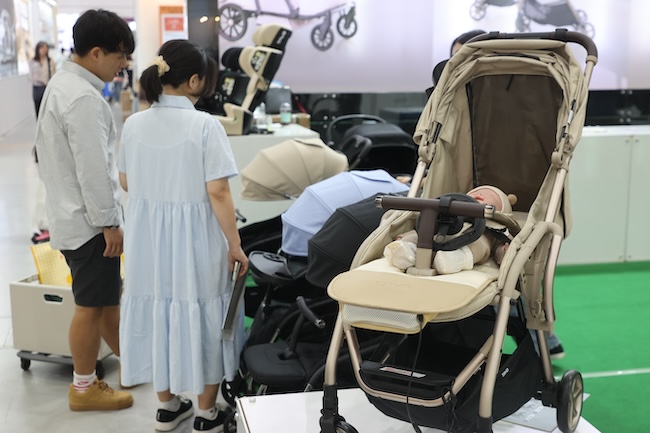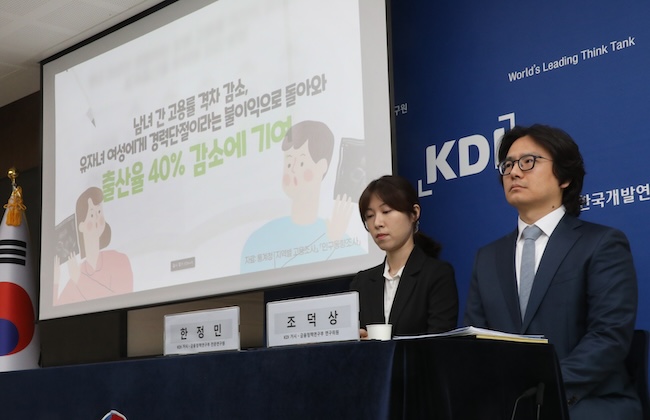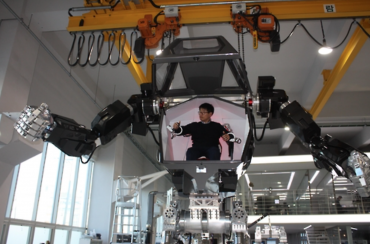
A procession of studies has highlighted the inverse relationship between women’s economic participation and birthrates in South Korea. (Image courtesy of Yonhap)
SEJONG, May 28 (Korea Bizwire) – A procession of studies has highlighted the inverse relationship between women’s economic participation and birthrates in South Korea, where childcare responsibilities still largely fall on mothers.
The International Monetary Fund recently urged South Korea and Japan to establish a positive cycle in which greater female workforce participation contributes to economic growth and addresses low fertility rates. To achieve this, the IMF recommended flexible work hours and shared domestic duties.
According to a report published last month by Statistics Korea, households where women were employed or where both spouses worked tended to have fewer children than households with non-working wives.
The researchers analyzed the correlation between household income, employment status and other factors with birthrates for households with spouses aged 25 to 44 over the past 20 years, using data from household surveys from 2003 to 2023.
As of last year, dual-income households averaged 1.36 children, fewer than the 1.46 children in male-breadwinner households.
The gap was most pronounced in the highest income quintile, where dual-income families had 1.43 children on average compared to 1.75 for male-breadwinner households, a difference of 0.32 children. Conversely, in the lowest two quintiles, dual-earner couples had slightly more children.
“Among low-income households, many may be unable to take parental leave for financial reasons, potentially resulting in more children for dual-income families,” the researchers said.
Similar patterns emerged when analyzed by the mother’s employment status.
Households with employed mothers averaged 1.34 children, compared to 1.48 children for those with non-working mothers, a gap of 0.27 children. In the top quintile, this gap widened to 0.34 children.
Regression analysis indicated that for every 100% increase in a woman’s income last year, the number of children decreased by about 4%, reflecting the negative correlation between female income and fertility. Male income, conversely, showed a positive correlation with larger family size.

The Korea Development Institute (KDI) released a report suggesting that the growing “child penalty” accounts for about 40% of the decline in birth rates from 2013 to 2019. (Image courtesy of Yonhap)
“To support working mothers having children, policies ensuring career continuity through parental leave, rather than career disruptions, are needed,” the researchers stated.
Last month, the Korea Development Institute (KDI) released a report suggesting that the growing “child penalty” – employment disadvantages symbolized by career interruptions – accounts for about 40% of the decline in birth rates from 2013 to 2019.
The study found that although the average career break rate for women in their 30s has steadily decreased over time, the decline has been concentrated among those without children.
Underlying this issue is the fundamental skew in South Korea toward women bearing the brunt of childcare and domestic responsibilities.
According to data from the Organization for Economic Cooperation and Development (OECD) and the Korea Development Institute (KDI), South Korean men engage in unpaid labor at only 23% of the rate of women, the second-lowest ratio after Japan’s 18% and Türkiye’s 22%. By contrast, the OECD average stands at 52%, more than twice the rate in South Korea.
In a report on South Korea and Japan released on May 21, the IMF highlighted the reality that women in these countries face delayed promotions, inequitable domestic responsibilities after marriage and childbirth. Consequently, late marriage and delayed childbearing have become common, significantly impacting declining birth rates.
The IMF noted that women in South Korea and Japan perform five times more unpaid domestic and caring labor than men, reflecting societal norms that disproportionately burden women.
Furthermore, the IMF pointed out that due to labor market dualities, many female workers are relegated to low-wage, temporary, or part-time positions. Long working hours and restrictions on remote work also make work arrangements unfriendly for families.
To address these challenges, the IMF advised supporting women’s employment and career advancement opportunities by promoting job mobility. It also recommended increasing childcare facilities, incentivizing paternity leave to boost men’s childcare involvement, and expanding remote work and flexible schedules.
The IMF believes that increasing female economic participation has contributed to economic growth, and narrowing gender gaps while changing cultural norms could help reverse declining birth rates.
“Reducing South Korea’s gender gap in working hours to the OECD average by 2035 could boost per capita GDP by 18%,” the IMF stated, emphasizing, “If South Korean and Japanese women can pursue fulfilling careers while raising families, they can ultimately make significant contributions to the economy and society.”
M. H. Lee (mhlee@koreabizwire.com)






